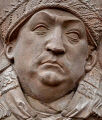Template:Selected anniversaries/June 15: Difference between revisions
Jump to navigation
Jump to search
No edit summary |
No edit summary |
||
| Line 4: | Line 4: | ||
File:Eclipse.jpg|link=Eclipse (nonfiction)|763 BC: Assyrians record a solar eclipse that is later used to fix the chronology of Mesopotamian history. | File:Eclipse.jpg|link=Eclipse (nonfiction)|763 BC: Assyrians record a solar eclipse that is later used to fix the chronology of Mesopotamian history. | ||
File:Johannes Trithemius.jpg|link=Johannes Trithemius (nonfiction)|1485 Feb. 1: lexicographer, chronicler, cryptographer, and occultist [[Johannes Trithemius (nonfiction)|Johannes Trithemius]] uses [[Gnomon algorithm]] techniques to generate improved solar eclipse forecasts. During the Second World War, this data will be used by German cryptographers to defeat enemy traffic analysis. | File:Johannes Trithemius.jpg|link=Johannes Trithemius (nonfiction)|1485 Feb. 1: lexicographer, chronicler, cryptographer, and occultist [[Johannes Trithemius (nonfiction)|Johannes Trithemius]] uses [[Gnomon algorithm]] techniques to generate improved solar eclipse forecasts. During the Second World War, this data will be used by German cryptographers to defeat enemy traffic analysis. | ||
||1640 – Bernard Lamy, French mathematician and theologian (d. 1715) | |||
||1648 – Margaret Jones is hanged in Boston for witchcraft in the first such execution for the Massachusetts Bay Colony. | |||
||1667 – The first human blood transfusion is administered by Dr. Jean-Baptiste Denys. | |||
||1752 – Benjamin Franklin proves that lightning is electricity (traditional date, the exact date is unknown). | |||
||1754 – Juan José Elhuyar, Spanish chemist and mineralogist (d. 1796) | |||
||1755 – Antoine François, comte de Fourcroy, French chemist and entomologist (d. 1809) | |||
||1765 – Johann Gottlieb Friedrich von Bohnenberger, German astronomer and mathematician (d. 1831) | |||
||1768 – James Short, Scottish mathematician and optician (b. 1710) | |||
||1844 – Charles Goodyear receives a patent for vulcanization, a process to strengthen rubber. | |||
||1878 – Eadweard Muybridge takes a series of photographs to prove that all four feet of a horse leave the ground when it runs; the study becomes the basis of motion pictures. | |||
||1894 – Nikolai Chebotaryov, Ukrainian-Russian mathematician and theorist (d. 1947) | |||
File:Gordon Welchman.jpg|link=Gordon Welchman (nonfiction)|1906: Mathematician, cryptographer, and author [[Gordon Welchman (nonfiction)|Gordon Welchman]] born. During the Second World War, he will develop traffic analysis techniques for breaking German codes. | File:Gordon Welchman.jpg|link=Gordon Welchman (nonfiction)|1906: Mathematician, cryptographer, and author [[Gordon Welchman (nonfiction)|Gordon Welchman]] born. During the Second World War, he will develop traffic analysis techniques for breaking German codes. | ||
||1914 – Hilda Terry, American cartoonist (d. 2006) | |||
||1915 – Thomas Huckle Weller, American biologist and virologist, Nobel Prize laureate (d. 2008) | |||
||1917 – John Fenn, American chemist and academic, Nobel Prize laureate (d. 2010) | |||
||1917 – Kristian Birkeland, Norwegian physicist and academic (b. 1867) | |||
||https://en.wikipedia.org/wiki/1920_Duluth_lynchings | ||https://en.wikipedia.org/wiki/1920_Duluth_lynchings | ||
||1927 – Ross Andru, American illustrator (d. 1993) | |||
File:The Eel Time-Surfing 2.jpg|link=The Eel Time-Surfing 2|1939: Art critic and alleged supervillain [[The Eel]] helps break German military codes using surf-powered [[The Eel Time-Surfing 2|gnomon algorithm]] techniques. | File:The Eel Time-Surfing 2.jpg|link=The Eel Time-Surfing 2|1939: Art critic and alleged supervillain [[The Eel]] helps break German military codes using surf-powered [[The Eel Time-Surfing 2|gnomon algorithm]] techniques. | ||
||1985 – Rembrandt's painting Danaë is attacked by a man (later judged insane) who throws sulfuric acid on the canvas and cuts it twice with a knife. | |||
File:John Atanasov.gif|link=John Vincent Atanasoff (nonfiction)|1995: Physicist, inventor, and academic [[John Vincent Atanasoff (nonfiction)|John Vincent Atanasoff]] dies. He invented the Atanasoff–Berry computer, the first electronic digital computer. | |||
||2012 – Nik Wallenda becomes the first person to successfully tightrope walk directly over Niagara Falls. | |||
||2013 – Kenneth G. Wilson, American physicist and academic, Nobel Prize laureate (b. 1936) | |||
</gallery> | </gallery> | ||
Revision as of 14:14, 8 October 2017
1485 Feb. 1: lexicographer, chronicler, cryptographer, and occultist Johannes Trithemius uses Gnomon algorithm techniques to generate improved solar eclipse forecasts. During the Second World War, this data will be used by German cryptographers to defeat enemy traffic analysis.
1906: Mathematician, cryptographer, and author Gordon Welchman born. During the Second World War, he will develop traffic analysis techniques for breaking German codes.
1939: Art critic and alleged supervillain The Eel helps break German military codes using surf-powered gnomon algorithm techniques.
1995: Physicist, inventor, and academic John Vincent Atanasoff dies. He invented the Atanasoff–Berry computer, the first electronic digital computer.




